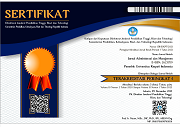Kajian Bisnis Plan PT CAP Tentang Hunian Rumah Di Kelurahan Semanan Jakarta Barat Tahun 2020-2024
Abstract
Penelitian ini merupakan penelitian operasional (OR) prediktif studi, dimaksudkan untuk membuat perhitungan tentang kelayakan rencana bisnis dengan mempertimbangkan berbagai faktor. Pendekatan yang digunakan adalah kualitatif, untuk mengkaji rencana bisnis yang dibuat oleh PT CAP dalam melakukan ekspansi bisnis di bidang propresi di wilayah Jakarta Barat.
Dari hasil penelitian yang telah penulis lakukan, didapatkan payback period didapatkan alternatif normal normal 36 bulan, alternatif optimis 24 bulan. Hasil ini jauh lebih kecil dari ketentuan manajemen 4 tahun, sehingga proyek ini layak untuk diterima. Analisis Net Present Value, dari hasil perhitungan NPV cash flow masih jauh lebih besar dari NPV cash outflow, artinya dari penilaian NPV proyek ini dinilai sangat layak untuk dilaksanakan. Internal Rate of Return (IRR) proyek ini layak karena jika mencari IRR, alternatif normal dan optimis lebih besar daripada biaya modal rata-rata tertimbang (WACC). Berdasarkan hasil analisis dan perhitungan yang telah dilakukan penulis sehubungan dengan proyek kawasan perumahan Citra Garden Puri Semanan di Semanan, Jakarta Barat, secara umum investasi tersebut dinilai layak dan menguntungkan tidak hanya bagi pengembang tetapi juga bagi konsumen yang membeli rumah di proyek tersebut. . Memperhatikan apa yang telah dianalisis dan dibahas, maka saran penulis adalah mengecek kembali arus kas dengan mempertimbangkan mencari alternatif pendanaan dengan pinjaman yang meningkat sehingga biaya modalnya kecil.
Kata Kunci : Payback Period, NPV, IRR
Full Text:
PDFReferences
Barney, J. B., (1991). Firm resources and sustained competitive advantage, Journal of Management, Vol. 17, pp.99-120.
Biro Pusat Statistik, Laporan Kunjungan Wisatawan Asing 2009, Jakarta : Biro Pusat Statistik, 2010.
Booms, B. H. and Bitner, M. J. (1981), “Marketing Strategies and Organization Structures for Service Firms,” in Donnelly, J. H. and George, W. R. (Eds), Marketing of services, Chicago: American Marketing Association, pp. 47- 51.
Collis, D. J., (1994). Research note: How valuable are organisational capabilities, Strategic Management Journal, Vol. 15, pp.143- 152.
Davidoff, D.M. (1994). Contact: Customer service in the hospitality and tourism industry. New York: Prentice Hall.
DeFranco, A & Lattin, T.,(2007). Hospitality financial management. New Jersey: John Wiley & Sons, Inc.
Dessler, G., (2000). Human resource management. 8th Ed., New Jersey: Prentice- Hall. Inc.
Ford, R. C. & Heaton, C. P., (2000). Managing the guest experience in hospitality, Albany, New York: Delmar Publishers.
Ford, R. C. & Heaton, C. P., (2001). Lessons from hospitality that can serve anyone, Organizational Dynamics Journal, Vol. 30, No. 1, pp. 30–47.
Foster, Dennis L., (1993). Rooms at the inn : Front office operation and administration. Singapore: Mc Graw-Hill International Editions.
Ghemawat, P., D. Collis, G. Pisano, and J. Rivkin. Strategy and the Business Landscape. Upper Saddle River, New Jersey: Prentice Hall.
Grant, R.M., (1991). The resource-based theory of competitive advantage: Implications for strategy formulation. California Management Review, Vol. 33, pp. 114–35
Grant, R.M., (2010). Contemporary strategy analysis, 7th Ed., New York: John Wiley and Sons.
Gray, W. S. & Liguori, S. C., (1994). Hotel and motel management and operations, 3th Ed., New Jersey : Prentice Hall, Inc.
Henderson, J.C., (2007). Corporate social responsibility and tourism: Hotel companies in Phuket, Thailand, after the Indian Ocean tsunami. Hospitality Management Journal, Vol. 26, pp. 228–239.
Henry, Anthony, (2007). Understanding strategic management, Oxford University Press.
Ivancevich, J. M.; Hoon, Lee Soon. (2002). Human Resource Management in Asia. Singapore : McGraw-Hill Education. A Division of The McGrow-Hill Companies.
Johnson, C. & Vanetti, M., (2005). Locational Strategies of international Hotel Chains. Annals of Tourism Research, Vol. 32, No. 4, pp. 1077–1099.
Kasali, Rhenald. (1998). Membidik Pasar Indonesia: Segmentasi, Targeting, Positioning. PT. Gramedia Pustaka Utama.
Keiser, J.R., (1989). Principles and practices of management in the hospitality industry. 2nd Ed, New York: Van Nostrand-Reinhold.
Kotler P. and Keller K.L. (2006), Marketing Management, 12th Edition, New Jersey : Prentice Hall.
Kotler, P., J. Bowen dan J. Makens. (1996). Marketing for Hospitality and Tourism. Prentice Hall, New York.
Kotler, Philip (1994). Marketing Management : Analysis, Planning, Implementation and Control. 8th Ed. New Jersey: Prentice Hall, Inc. A Paramount Communications Company.
Kotler, Philip. 2009. Manajemen Pemasaran Edisi 12. Jakarta.
Kotler, Philip., dan Armstrong. 2013. Marketing Management. 15th Edition. Pearson Prentice Hill.
Kotler. (1997). Manajemen Pemasaran (Terjemahan), Jakarta : Preghallindo.
Lam, T. & Han, M. X. J., (2005). A study of outsourcing strategy: a case involving the hotel industry in Shanghai, China. Hospitality Management Journal, Vol. 24, pp. 41–56.
Lane, Keller Kevin, (2008). Strategic brand mangement : Building, measuring and managing brand equity. 3th Ed, New Jersey : Prentisce Hall.
Lewis, R. C. and Chambers, R. E., (1989). Marketing leadership in hospitality, New York: Van NostrandReinhold.
Li Song, (2008). An analysis on chinese hotel enterprises outsourcing strategic modes and corresponding development conception, International Journal of Business and Management, Vol. 3, No.3 pp. 76–81.
Lovelock, CH and Wirtz J. (2007). Services Marketing. 7th Ed. United States of America: Pearson International Edition.
Magretta, J., (2002). Why business models matter, Harvard Business Review, Vol. 80, No 3. pp. 86-92
McCabe, V.S., (2008). Strategies for career planning and development in the Convention and Exhibition industry in Australia, Hospitality Management Journal, Vol. 27, pp. 222–231
Mittal, B., Baker, J., 2002. Advertising strategies for hospitality services: Because services are intangible, hospitality advertising must overcome the quadruple challenges of abstraction, generality, mental impalpability, and non- searchability. Cornell Hotel & Restaurant Quarterly Journal, Vol. 43 (2), pp. 51–63.
Nebel, Eddystone C., (1991). Managing hotels effectively : Lessons from outstanding general managers, New York: Van NostrandReinhold.
Peteraf, M. A., (1993). The cornerstones of competitive advantage: A resource- based view, Strategic Management Journal, Vol. 14, pp. 179-191.
Phillips, P. A., (1996). Strategic planning and business performance in the quoted UK hotel sector: Results of an exploratory study. Hospitality Management Journal, Vol. 15 No 4, pp. 347–362.
Pizam, A., (1993). Managing cross-cultural hospitality enterprises. In the international hospitality industry: Organizational and operational issues, eds. London: P. Jones and A. Pizam. Pitman Publishing.
Porter, M. E. (1980). Competitive Strategy: Techniques for analysing industries and competitors. Free Press, New York.
Porter, M. E. (1985). Competitive advantage, The Free Press, New York, NY. Porter, M. E. (1996). What is strategy? Harvard Business Review, Vol 74(6).
DOI: https://doi.org/10.52643/jam.v11i2.1888
Refbacks
- There are currently no refbacks.
StatCounter

This work is licensed under a Creative Commons Attribution-ShareAlike 4.0 International License.












